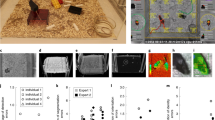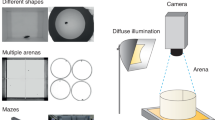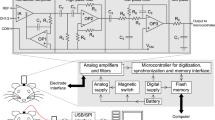Abstract
Evaluating the behavior of mice and rats has substantially contributed to the progress of research in many scientific fields. Researchers commonly observe recorded video of animal behavior and manually record their observations for later analysis, but this approach has several limitations. The authors developed an automated system for tracking and analyzing the behavior of rodents that is based on radio frequency identification (RFID) in an ultra-high-frequency bandwidth. They provide an overview of the system's hardware and software components as well as describe their technique for surgically implanting passive RFID tags in mice. Finally, the authors present the findings of two validation studies to compare the accuracy of the RFID system versus commonly used approaches for evaluating the locomotor activity and object exploration of mice.
This is a preview of subscription content, access via your institution
Access options
Subscribe to this journal
We are sorry, but there is no personal subscription option available for your country.
Buy this article
- Purchase on Springer Link
- Instant access to full article PDF
Prices may be subject to local taxes which are calculated during checkout









Similar content being viewed by others
References
Wöhr, M. & Scattoni, M.L. Behavioural methods used in rodent models of autism spectrum disorders: current standards and new developments. Behav. Brain Res. 251, 5–17 (2013).
Bonadonna, F., Lea, M. & Guinet, C. Foraging routes of Antarctic fur seals (Arctocephalus gazella) investigated by the concurrent use of satellite tracking and time-depth recorders. Polar Biol. 23, 149–159 (2000).
Neisen, G. Validation of a local positioning monitoring system (LPM) in relation to dairy cow behavior. Second Annual Symposium of the PhD-Programme for Sustainable Agriculture ASPSA, Zurich, Switzerland (4 November 2005).
Kritzler, M., Lewejohann, L., Krüger, A., Raubal, M. & Sachser, N. An RFID-based tracking system for laboratory mice in a semi-natural environment. 4th International Conference on Pervasive Computing Technologies for Healthcare, Innsbruck, Austria (29 November 2006).
Aguzzi, J. et al. A new laboratory radio frequency identification (RFID) system for behavioural tracking of marine organisms. Sensors (Basel) 11, 9532–9548 (2011).
Catarinucci, L. et al. An RFID tracking system supporting the behavior analysis of colonial laboratory animals. Int. J. RF Tech. Res. Appl. 5, 63–80 (2013).
Catarinucci, L. et al. Near field UHF RFID antenna system enabling the tracking of small laboratory animals. Int. J. Antenn. Propag. 2013, 713943 (2013).
Catarinucci, L. et al. Performance evaluation of a novel animals tracking system based on UHF RFID technology. JCOMSS 9, 4–13 (2013).
Kløve, T., Lin, T., Tsai, S. & Tzeng, W. Permutation arrays under the Chebyshev distance. IEEE T. Inform. Theory 56, 2611–2617 (2010).
Blanchard, R.J., McKittrick, C.R. & Blanchard, D.C. Animal models of social stress: effects on behavior and brain neurochemical systems. Physiol. Behav. 73, 261–271 (2001).
Matsumoto, K., Pinna, G., Puia, G., Guidotti, A. & Costa, E. Social isolation stress-induced aggression in mice: a model to study the pharmacology of neurosteroidogenesis. Stress 8, 85–93 (2005).
Matsumoto, K., Puia, G., Dong, E. & Pinna, G. GABA(A) receptor neurotransmission dysfunction in a mouse model of social isolation-induced stress: possible insights into a non-serotonergic mechanism of action of SSRIs in mood and anxiety disorders. Stress 10, 3–12 (2007).
Pinna, G. et al. Neurosteroid biosynthesis regulates sexually dimorphic fear and aggressive behavior in mice. Neurochem. Res. 33, 1990–2007 (2008).
Pieretti, S., Dal Piaz, V., Matucci, R., Giovannoni, M.P. & Galli, A. Antinociceptive activity of a 3(2H)-pyridazinone derivative in mice. Life Sci. 65, 1381–1394 (1999).
Dere, E., Huston, J.P. & De Souza Silva, M.A. The pharmacology, neuroanatomy and neurogenetics of one-trial object recognition in rodents. Neurosci. Biobehav. Rev. 31, 673–704 (2007).
Author information
Authors and Affiliations
Corresponding author
Ethics declarations
Competing interests
The authors declare no competing financial interests.
Rights and permissions
About this article
Cite this article
Catarinucci, L., Colella, R., Mainetti, L. et al. An animal tracking system for behavior analysis using radio frequency identification. Lab Anim 43, 321–327 (2014). https://doi.org/10.1038/laban.547
Received:
Accepted:
Published:
Issue Date:
DOI: https://doi.org/10.1038/laban.547
This article is cited by
-
Nesting behavior is associated with body weight and grip strength loss in mice suffering from experimental arthritis
Scientific Reports (2023)
-
Design and test of intelligent inspection and monitoring system for cotton bale storage based on RFID
Scientific Reports (2022)
-
Lack of adverse effects during a target animal safety trial of extended-release buprenorphine in Fischer 344 rats
Lab Animal (2016)



